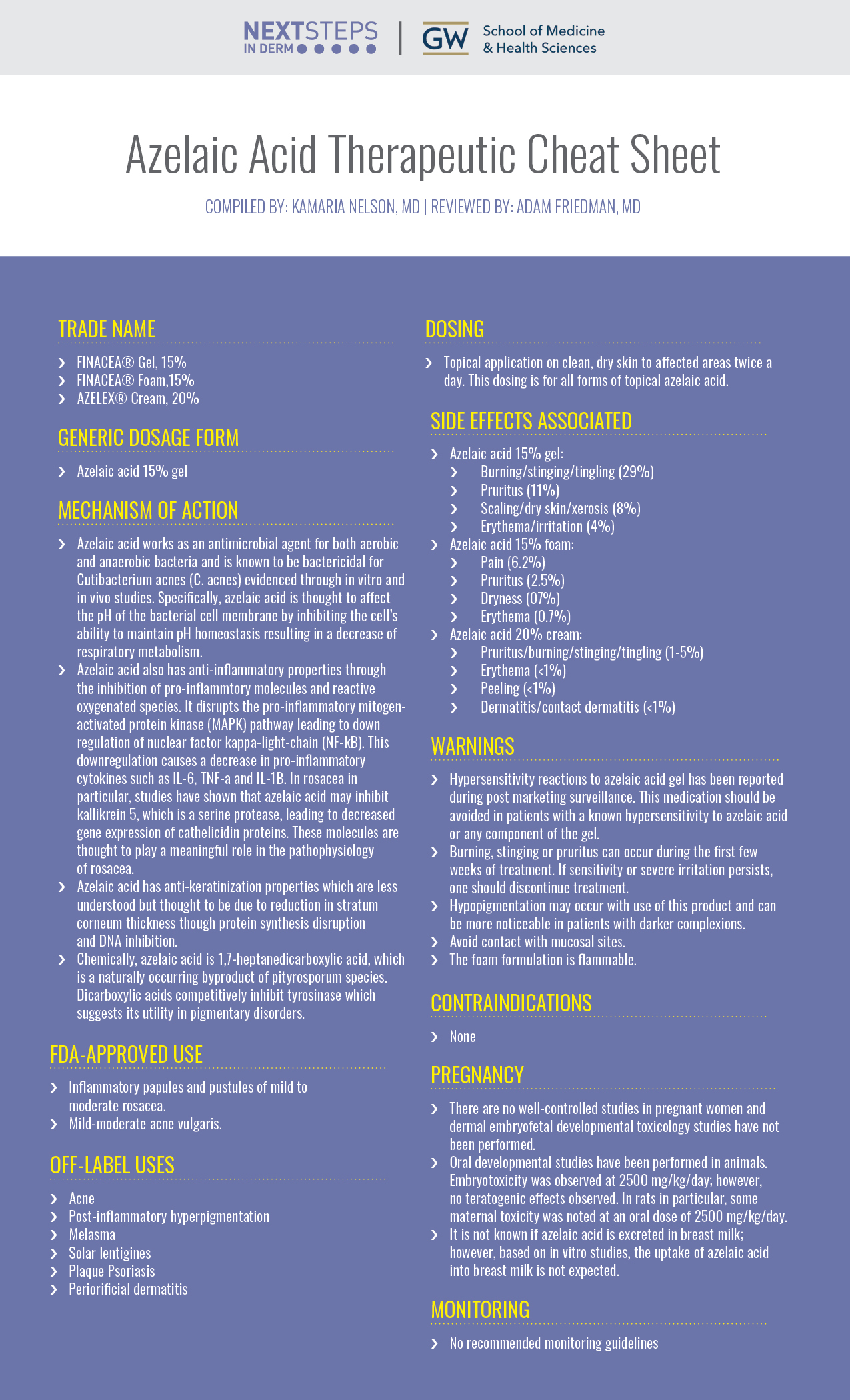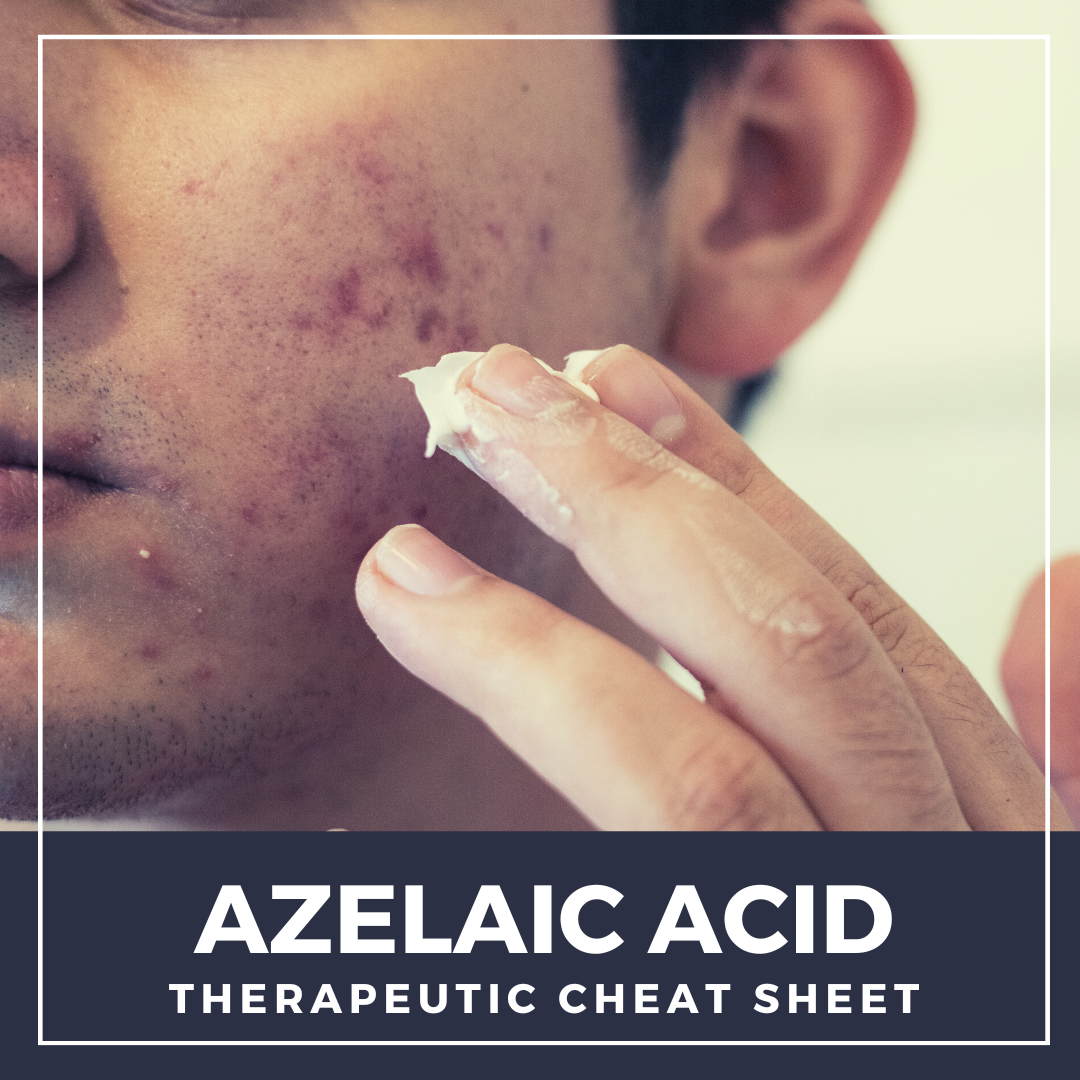Azelaic acid is a topical therapeutic agent which is FDA approved to treat papules and pustules of mild to moderate rosacea and mild to moderate acne vulgaris. It was first approved by the FDA in 1995 and since its approval, has been used for many off-label conditions including disorders of hyperpigmentation. Its utility in various conditions can be attributed to its anti-microbial, anti-inflammatory, anti-keratinization, and anti-melanogenesis properties. It is commonly recommended in pregnant patients as an alternative to tretinoin for acne vulgaris; however, there have not been many controlled studies evaluating its safety in this patient population. We continue our series, Therapeutic Cheat Sheet, with a closer look at topical azelaic acid.
Azelaic Acid Therapeutic Cheat Sheet
Compiled by: Kamaria Nelson, MD, Reviewed by: Adam Friedman, MD
TRADE NAME
-
- FINACEA® Gel, 15%
- FINACEA® Foam,15%
- AZELEX® Cream, 20%
GENERIC DOSAGE FORM
-
- Azelaic acid 15% gel
MECHANISM OF ACTION
-
- Azelaic acid works as an antimicrobial agent for both aerobic and anaerobic bacteria and is known to be bactericidal for Cutibacterium acnes ( acnes) evidenced through in vitro and in vivo studies. Specifically, azelaic acid is thought to affect the pH of the bacterial cell membrane by inhibiting the cell’s ability to maintain pH homeostasis resulting in a decrease of respiratory metabolism.
- Azelaic acid also has anti-inflammatory properties through the inhibition of pro-inflammtory molecules and reactive oxygenated species. It disrupts the pro-inflammatory mitogen-activated protein kinase (MAPK) pathway leading to down regulation of nuclear factor kappa-light-chain (NF-kB). This downregulation causes a decrease in pro-inflammatory cytokines such as IL-6, TNF-a and IL-1B. In rosacea in particular, studies have shown that azelaic acid may inhibit kallikrein 5, which is a serine protease, leading to decreased gene expression of cathelicidin proteins. These molecules are thought to play a meaningful role in the pathophysiology of rosacea.
- Azelaic acid has anti-keratinization properties which are less understood but thought to be due to reduction in stratum corneum thickness though protein synthesis disruption and DNA inhibition.
- Chemically, azelaic acid is 1,7-heptanedicarboxylic acid, which is a naturally occurring byproduct of pityrosporum species. Dicarboxylic acids competitively inhibit tyrosinase which suggests its utility in pigmentary disorders.
FDA-APPROVED USE
-
- Inflammatory papules and pustules of mild to moderate rosacea.
- Mild-moderate acne vulgaris.
OFF-LABEL USES
-
- Acne
- Post-inflammatory hyperpigmentation
- Melasma
- Solar lentigines
- Plaque Psoriasis
- Periorificial dermatitis
DOSING
-
- Topical application on clean, dry skin to affected areas twice a day. This dosing is for all forms of topical azelaic acid.
SIDE EFFECTS ASSOCIATED
Azelaic acid 15% gel:
-
- Burning/stinging/tingling (29%)
- Pruritus (11%)
- Scaling/dry skin/xerosis (8%)
- Erythema/irritation (4%)
Azelaic acid 15% foam:
-
- Pain (6.2%)
- Pruritus (2.5%)
- Dryness (07%)
- Erythema (0.7%)
Azelaic acid 20% cream:
-
- Pruritus/burning/stinging/tingling (1-5%)
- Erythema (<1%)
- Peeling (<1%)
- Dermatitis/contact dermatitis (<1%)
WARNINGS
-
- Hypersensitivity reactions to azelaic acid gel has been reported during post marketing surveillance. This medication should be avoided in patients with a known hypersensitivity to azelaic acid or any component of the gel.
- Burning, stinging or pruritus can occur during the first few weeks of treatment. If sensitivity or severe irritation persists, one should discontinue treatment.
- Hypopigmentation may occur with use of this product and can be more noticeable in patients with darker complexions.
- Avoid contact with mucosal sites.
- The foam formulation is flammable.
CONTRAINDICATIONS
-
- None
PREGNANCY
-
- There are no well-controlled studies in pregnant women and dermal embryofetal developmental toxicology studies have not been performed.
- Oral developmental studies have been performed in animals. Embryotoxicity was observed at 2500 mg/kg/day; however, no teratogenic effects observed. In rats in particular, some maternal toxicity was noted at an oral dose of 2500 mg/kg/day.
- It is not known if azelaic acid is excreted in breast milk; however, based on in vitro studies, the uptake of azelaic acid into breast milk is not expected.
MONITORING
-
- No recommended monitoring guidelines
Overall, topical azelaic acid is a safe and effective therapy for the treatment of mild to moderate rosacea and acne vulgaris. There exist several forms, with the cream formulation appearing to be the most tolerable based on clinical trial data. Studies have shown improvement in the papules and pustules of rosacea; however, the improvement of erythema has not been studied in clinical trials. Therefore, it may be necessary to combine azelaic acid with other treatment modalities to help with the improvement of erythema associated with rosacea. Newer studies have found azelaic acid to be effective in the treatment of disorders of hyperpigmentation, including melasma in addition to disorders of keratinization such as plaque psoriasis. Practitioners should continue to take note of newly published reports concerning the safety of his therapeutic option in the diversity of clinical settings in which it is utilized.

FURTHER READING
Efficacy of 15% azelaic acid in psoriasis vulgaris: a randomized, controlled clinical trial, published in Journal of Drugs in Dermatology
Fariba Iraji, et al.
Abstract:
Background: Psoriasis is a common disorder affecting 1-3 percent of the general global population. Many therapeutic modalities have been suggested for treatment of this condition, but still there is no definite treatment for this disease. The objective in this study was to evaluate the efficacy of topical azelaic acid gel versus placebo in the treatment of psoriasis vulgaris.
Patients, materials and methods: This study was a single-blinded randomized clinical trial. Overall, 31 patients were selected and the left or right sided lesions of the patients were randomized to receive either 15% azelaic acid or gel twice daily for a one-month period. Two symmetrical lesions with almost similar severity in every patient were selected and considered as index lesions to evaluate lesion response to treatment. The severity of erythema, scaling, hyperkeratosis and pruritus of the index lesions were scored in range of 0-3 for each lesion by the investigator at the baseline and follow up visits. The percent of involvement of each side of body was also measured using rule of nines. The collected data were analyzed using statistical tests including Mann-Whitney and ANOVA tests.
Results: There was no significant difference between the two groups before treatment (P > 0.05). After treatment, however, except pruritus, there was significant difference between the two groups (P < 0.05). There was no significant difference regarding total psoriasis score between the two groups before treatment (P > 0.05). After treatment, however, there was significant difference between the two groups (P < 0.05) in favor of more efficacy for azelaic acid. There was no significant difference regarding percent of body involvement between the two groups before treatment (P > 0.05). After treatment, however, there was a significant difference between the two groups (P < 0.05) in favor of more efficacy on the part of azelaic acid gel.
Discussion: The results of our study showed that 15% azelaic acid gel was effective in reduction of purities, scaling and hyperkeratosis of psoriasis plaques. This treatment was also effective in reduction of skin involvement with psoriasis. It is recommended that a longer study be performed that can better evaluate the efficacy of this treatment against plaque-type psoriasis.
The Therapeutic Use of Antioxidants for Melasma, published in Journal of Drugs in Dermatology
Kayla M Babbush, et al.
Abstract:
Melasma is a chronic dermatologic condition with an incompletely understood pathogenesis and well-demonstrated impact on patient quality of life. Melasma is a common cause for seeking dermatologic care, and with no universally efficacious therapy or cure, com-bination treatment is the best approach for many cases. Numerous studies have demonstrated the role of oxidative stress in patients with melasma, prompting investigation into several antioxidants for melasma therapy. In this review, we discuss the well-defined role of oxidative stress in melasma and the therapeutic efficacy of various antioxidants for patients suffering from melasma. We focus our discussion on studies investigating the role of vitamin C, azelaic acid, cysteamine, glutathione, carotenoids, and numerous other antioxidants in disorders of hyperpigmentation. There is promising evidence for the use of these antioxidants, as topical, oral, and intra-venous preparations, both in isolation and in conjunction with other melasma therapies.
References
-
- Bayer HealthCare Pharmaceuticals: FINACEA® (azelaic acid) gel for topical use. Package Insert. US Prescribing Information and Patient Information. Revised 04/2015. Available at: https://www.accessdata.fda.gov/drugsatfda_docs/label/2015/021470s010lbl.pdf
- ALLERGAN: AZELEX® (azelaic acid cream) 20% for topical use. Package Insert. US Prescribing Information and Patient Information. Revised 06/2003. Available at:https://www.accessdata.fda.gov/drugsatfda_docs/label/2003/20428slr016_azelex_lbl.pdf
- Bayer HealthCare Pharmaceuticals: FINACEA® (azelaic acid) foam for topical use. Package Insert. US Prescribing Information and Patient Information. Revised 07/2015. Available at: https://www.accessdata.fda.gov/drugsatfda_docs/label/2015/207071s000lbl.pdf
- Yamasaki Y, Gallo RL. Azelaic acid gel alters kallikrein 5 and cathelicidin expression in epidermal keratinocytes, critical elements in the pathogenesis of rosacea. J Am Acad Dermatol. 2010;62:AB1.
- Schulte BC, Wu W, Rosen T. Azelaic Acid: Evidence-based Update on Mechanism of Action and Clinical Application. J Drugs Dermatol. 2015 Sep;14(9):964-8. PMID: 26355614.
- Kong YL, Tey HL. Treatment of acne vulgaris during pregnancy and lactation. Drugs. 2013 Jun;73(8):779-87. doi: 10.1007/s40265-013-0060-0. PMID: 23657872.
- Gomolin T, Cline A, Pereira F. Treatment of rosacea during pregnancy. Dermatol Online J. 2021 Jul 15;27(7). doi: 10.5070/D327754360. PMID: 34391325.
- Babbush KM, Babbush RA, Khachemoune A. The Therapeutic Use of Antioxidants for Melasma. J Drugs Dermatol. 2020 Aug 1;19(8):788-792. doi: 10.36849/JDD.2020.5079. PMID: 32845595.
- Iraji F, Faghihi G, Siadat AH, Enshaieh S, Shahmoradi Z, Joia A, Soleimani F. Efficacy of 15% azelaic acid in psoriasis vulgaris: a randomized, controlled clinical trial. J Drugs Dermatol. 2010 Aug;9(8):964-8. PMID: 20684146.
- Wolverton SE, Wu JJ. Comprehensive Dermatologic Drug Therapy. Fourth edition. (Wolverton SE, Wu JJ, eds.). Elsevier; 2021.
Did you enjoy this Therapeutic Cheat Sheet? You can find more here.

